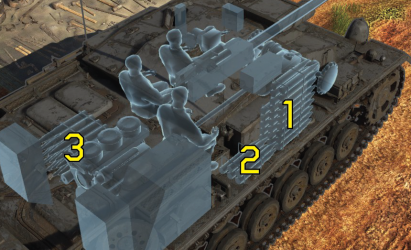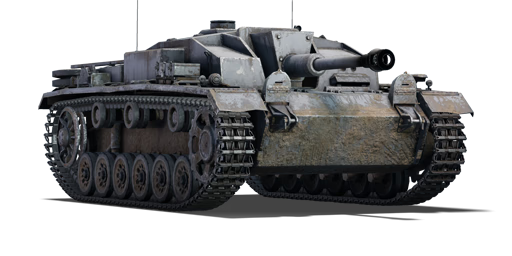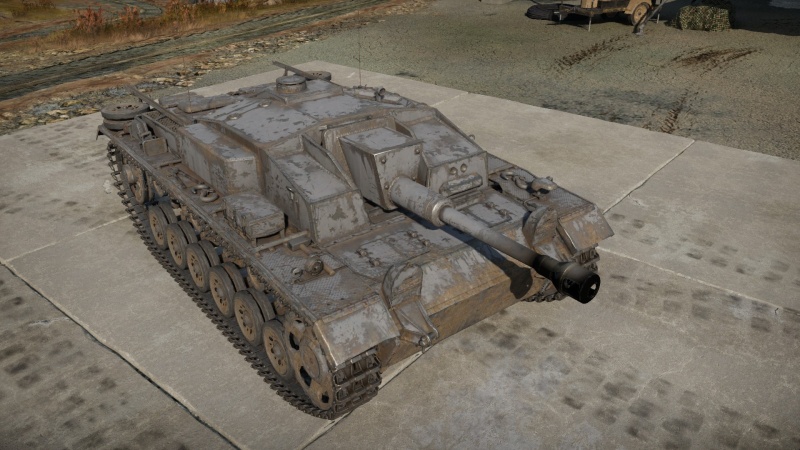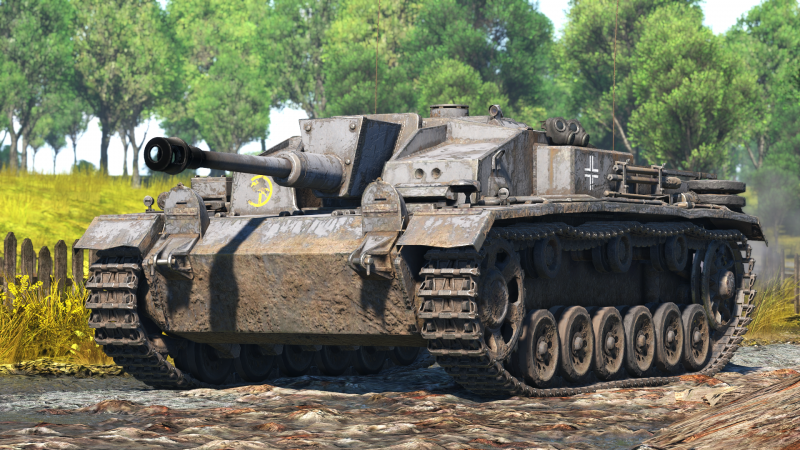StuG III F
| This page is about the German tank destroyer StuG III F. For other versions, see StuG III (Family). |
Contents
Description
The Sturmgeschütz III Ausf. F (StuG III F) is a rank II German tank destroyer with a battle rating of 3.3 (AB/RB/SB). It was introduced during the Closed Beta Test for Ground Forces before Update 1.41. An improvement over the StuG III A with the installation of the longer 75 mm StuK 40 L/43 gun.
This tank destroyer has a very high first-shot knock-out ability, due to the superb penetration, damage and accuracy of its gun. Right off the bat, the gun will easily penetrate medium tanks and the KV-1 at certain ranges, and the APCR ammo can consistently pen KV-1's at most ranges. Furthermore, its gun is very accurate and with proper range-finding and aim, hitting the bow gunner's port on a T-34 is possible from 800 meters. However, its frontal armour is insufficient for any form of "slugging match" and its reload time is extensive, so it should be used at long-medium ranges and moved into cover once a shot is fired.
General info
Survivability and armour
With a maximum of only 50 mm of armour on the superstructure, the StuG III Ausf. F is vulnerable to most guns that it faces, and even to lower rank vehicles if they get close enough. It must instead rely on its low profile in order to stay hidden and avoid incoming fire.
The driver, commander, and gunner are seated in a row on the left side of the tank, and a single shot that penetrates that side of the superstructure will usually result in all three of them being disabled, rendering the StuG III completely helpless. On the left side is the loader as well as a generous ammunition rack, and shots to that side of the tank usually result in a much quicker return to the hangar.
It should also be noted that the thin roof armour can be vulnerable to aircraft cannon fire, or even heavy machine guns at very close ranges.
Armour type:
- Rolled homogeneous armour
| Armour | Front (Slope angle) | Sides | Rear | Roof |
|---|---|---|---|---|
| Hull | 30 mm (86°), 50 mm (50°) Front glacis 50 mm (23°) Lower glacis |
30 mm | 30 mm (33°) Top 30 mm (11°) Bottom |
17 mm |
| Superstructure | 50 mm (9-10°), 30 mm (76°) | 30 mm | 30 mm (26-30°) | 11 mm |
Notes:
- Suspension wheels are 15 mm thick while tracks are 20 mm thick.
Mobility
| Game Mode | Max Speed (km/h) | Weight (tons) | Engine power (horsepower) | Power-to-weight ratio (hp/ton) | |||
|---|---|---|---|---|---|---|---|
| Forward | Reverse | Stock | Upgraded | Stock | Upgraded | ||
| Arcade | 44 | 9 | 22.7 | 426 | 572 | 18.77 | 25.2 |
| Realistic | 41 | 8 | 265 | 300 | 11.67 | 13.22 | |
The mobility of the StuG III F is very similar to that of the Panzer III medium tank on which it is based. It is quite adequate for relocating and keeping up with other tanks.
Modifications and economy
Armaments
Main armament
The 7,5 cm StuK 40 L/43 is almost identical to the 7,5 cm KwK 40 L/43 on the Pz.IV F2. It is one of the best guns in the game for its rank, combining excellent penetration, lethal APHE shells, high velocity, average rate of fire, and high accuracy, complementing the StuG's playstyle as a medium/long range tank destroyer. Unfortunately, the StuG III does not have the gun depression of the PzKpfw IV F2, and thus is not so good at taking advantage of terrain.
The StuK 40 also has access to an APCR round with excellent penetration, but its lethality is a lot worse than the APHE shell and it is very rare that the extra penetration is needed. The HEAT round is not worthy of consideration since its penetration is inferior to the APHE round's penetration at ranges up to 2,000 m.
| 75 mm StuK40 | Turret rotation speed (°/s) | Reloading rate (seconds) | |||||||||||
|---|---|---|---|---|---|---|---|---|---|---|---|---|---|
| Mode | Capacity | Vertical | Horizontal | Stabilizer | Stock | Upgraded | Full | Expert | Aced | Stock | Full | Expert | Aced |
| Arcade | 44 | -6°/+17° | ±10° | N/A | 13.2 | 18.3 | 22.2 | 24.6 | 26.1 | 7.67 | 6.79 | 6.25 | 5.90 |
| Realistic | 8.9 | 10.5 | 12.8 | 14.1 | 15.0 | ||||||||
Ammunition
| Penetration statistics | |||||||
|---|---|---|---|---|---|---|---|
| Ammunition | Type of warhead |
Penetration @ 0° Angle of Attack (mm) | |||||
| 10 m | 100 m | 500 m | 1,000 m | 1,500 m | 2,000 m | ||
| PzGr 39 | APCBC | 137 | 135 | 123 | 110 | 98 | 88 |
| Hl.Gr 38B | HEAT | 80 | 80 | 80 | 80 | 80 | 80 |
| PzGr 40 | APCR | 163 | 159 | 143 | 126 | 110 | 96 |
| Sprgr. 34 | HE | 10 | 10 | 10 | 10 | 10 | 10 |
| Shell details | |||||||||
|---|---|---|---|---|---|---|---|---|---|
| Ammunition | Type of warhead |
Velocity (m/s) |
Projectile Mass (kg) |
Fuse delay (m) |
Fuse sensitivity (mm) |
Explosive Mass (TNT equivalent) (g) |
Ricochet | ||
| 0% | 50% | 100% | |||||||
| PzGr 39 | APCBC | 740 | 6.8 | 1.2 | 14 | 28.9 | 48° | 63° | 71° |
| Hl.Gr 38B | HEAT | 450 | 4.4 | 0.05 | 0.1 | 872.1 | 62° | 69° | 73° |
| PzGr 40 | APCR | 919 | 4.1 | N/A | N/A | N/A | 66° | 70° | 72° |
| Sprgr. 34 | HE | 550 | 5.74 | 0 | 0.1 | 686 | 79° | 80° | 81° |
| Smoke shell characteristics | ||||||
|---|---|---|---|---|---|---|
| Ammunition | Velocity (m/s) |
Projectile Mass (kg) |
Screen radius (m) |
Screen deploy time (s) |
Screen hold time (s) |
Explosive Mass (TNT equivalent) (g) |
| K.Gr.Rot Nb. | 540 | 6.2 | 13 | 5 | 20 | 50 |
Ammo racks

| Full ammo |
1st rack empty |
2nd rack empty |
3rd rack empty |
Visual discrepancy |
|---|---|---|---|---|
| 44 | 22 (+22) | 17 (+27) | 1 (+43) | No |
Note:
- Front right empty: 22 (+22) shells.
Usage in battles
StuGs, with their thin side and top armour, should be careful of their position. If operating alone, StuGs should either move to the flanks in order to catch the enemy unaware, or operate behind friendly lines. Staying behind cover is preferable, although many rock formations will block the gun trajectory (whilst other tanks can simply shoot over them). Do always keep at least one flank covered, if the enemy is within range.
A particularly useful indicator is the Marder III. It features a similar gun, but are taller, and has a largely exposed crew. As a result of the latter, Marders are very fragile. If a Marder survives in a certain position, then the StuG is likely to do too.
The best tactic, of course, is to operate in cooperation with the team.
Operate in a squad with other StuGs, and at least one Pv.IV or Pz.III. They are taller, and might thus attract the enemy's attention, but draw fire away from the StuG for support while the StuG uses its powerful gun to destroy the enemy before it destroys the allied medium tanks.
When fighting without support, relocate after each shot as the StuG III is sufficiently mobile to evade detection often; also, if the team does not have air superiority, seek wooded areas, as otherwise any plane armed with 20 mm cannons can attempt to penetrate through the thin roof armour.
Enemies worth noting:
- ZSD63: this SPAA has access to a full AP belt with 60+mm of penetration which makes it able to penetrate the StuG from any angle (even frontally) up close, and its quick rate of fire can finish all your crews with a short burst. Do not shoot at the hull below the turret as there is absolutely nothing inside, shoot the turret or the front hull. Multiple shots might be needed as its armour is so thin your shells will not detonate. Slightly angle your tank when reloading to avoid it penetrating your thin vertical armour. It has a rather boxy and tall hull with a geometric turret sitting at the back, slightly similar to a Wirbelwind's. You can also tell by looking at how it fires: the sound and green tracers are very rapid, much like a buzzsaw, but then it will remain silent for half a minute reloading. Note that an experienced ZSD player will hold its fire or shoot in single salvos with long halts between, making it look like that it's reloading.
Pros and cons
Pros:
- Powerful 75 mm cannon with decent penetration, great accuracy and velocity, and a piercing APCR shell: even with the stock AP it can frontally one-shot most opponents like M4, T-34, M24 or even the KV-1
- Good mobility for relocating quickly
- Large gun mantlet and sections of highly sloped armour often deflect poorly aimed shots
- Low silhouette makes the StuG easy to conceal in RB and SB
- Completely enclosed vehicle means it resists strafing aircraft and artillery better than other SPGs
Cons:
- Poor survivability: weak, unsloped frontal armour of only 50 mm easily gets penetrated by common tanks like the T-34, 75 mm M4 or even M3 Stuarts, and once penetrated 3 crew are lined up for the shot, destroying the StuG
- Rather limited gun depression limits its capacity in hills
- Lack of a turret makes reacting to flanking enemies harder, especially against common opponents such as the M24, M22 and GAZ trucks
- Obstacles on the ground (eg. stone walls) can easily block the low-profile StuG's view and gun
History
Development
The role of a self-propelled gun came from combat experiences in World War I. During the German offensives on the Allied front, infantry lacked artillery support against fortifications in places out-ranged by their heavy artillery behind the lines. A need for a mobile artillery piece was necessary to keep up with the German infantry and fight enemy fortifications with a direct-fire assault role. The father of this concept was German General Erich von Manstein and was coined as the Sturmartillerie (assault artillery), and these units were to be embedded in infantry divisions.
On June 15, 1936, Daimler-Benz AG was ordered to develop a support vehicle mounting the 75 mm howitzer as its armament in a casemate structure with a traverse of 25 degrees. The vehicle was to provide full protection for its crew and be no taller than an average soldier. Daimler-Benz repurposed the chassis and running gear of their Panzer III design for the role. These new vehicles were named the Sturmgeschütz III (assault gun), or the shortened StuG III and the finished designs were sent to Alkett for prototype production and five were produced in 1937. These prototypes were made of mild steel and had the 75 mm StuK 37 L/24 cannon, an adaption of the original 75 mm KwK 37 cannon on the Panzer IV. This gun would be featured on the StuG III variants Ausf. A to Ausf. E. The StuG III entered production from January 1940 to the end of the war on April 1945 due to the many upgrades done on the vehicle to increase serviceability and its low cost. At about a total production of 11,300 StuG III and its variants, the StuG III design was the most produced armoured fighting vehicle in German service.
Design
The StuG III had a fully enclosed armoured shell, keeping the crew safe within the vehicle. As a casemate structure, it has a limited traverse range for its front view, and the whole vehicle must be turned if a target is outside its traverse range. The StuG III featured about 50 mm of armour on the front, but about 30 mm of armour everywhere else, this was upgraded as the war progressed to 80 mm. The suspension system is identical to the Panzer III's, a torsion bar system. The StuG III had a crew of four, the commander, driver, loader, and gunner. Initial variants lack machine guns, so the StuG was required to work with support units to ensure it does not get overrun by infantry. It wasn't until December 1942 when a machine gun could be accommodated for the loader to use. Initial variants also did not have a commander's cupola so his view was quite restricted. However, models after September 1943 had them installed.
Combat usage
The StuG III was placed in the artillery branch of the Wehrmacht Heer as neither the infantry nor Panzer forces could accept the StuG vehicle. The StuGs were organized into battalions with 18 vehicles organized into three batteries of six vehicles each. The intent of the vehicle was to provide close support for infantry and so it was meant to destroy lightly-armoured targets and fortifications, not tanks. The vehicle served well in its intended role in the early parts of World War II in Poland and France Campaigns, proving highly successful. One prominent commander of the StuG III is Michael Wittman, who would eventually become the most popular tank ace in German service. However, during the German campaigns in World War II, they encounter more heavily armoured and armed tanks in the Allied sides, such as the French heavy tank Char B1, but it was the Soviets T-34 and KV-1 tanks that made the Germans rearm their vehicles to be better able to combat these tanks.
The initial Stug III design was up-gunned to better combat these newer tanks. The original 75 mm StuK 37 was inadequate so like the Panzer IVs, it was given a 75 mm StuK 40 L/43 cannon. This variant was the Ausf. F and with its new cannon, could penetrate about 91 mm of armour inclined at 30 degrees at 500 meters distance, being able to engage the Soviet T-34 designs. This upgrade changed the StuG III role from its usual infantry support role into a tank destroyer, though it can serve both roles with acceptable performance. The design was changed with an exhaust fan on top of the vehicle to vent out propellant fume that could accumulate in the tank from firing the cannon. An additional 30 mm of armour was welded on the tank to up the front armour from 50 mm to 80 mm in thickness. This, plus with the StuG III's low profile makes its concealment very easy to ambush tanks with its powerful 75 mm cannon. Some later models from December 1942 onward have the StuG III Ausf. F mounted the longer 75 mm StuK 40 L/48 cannon more commonly seen on the Ausf. G variant. Another redesign in 1942 had the StuG III chassis built from the improved Panzer III Ausf. J and Ausf. L with better rear armour protection and hull design. This redesigned variant was called the Ausf. F/8. About 616 StuG III Ausf. F and F/8 were produced from March 1942 to December 1942.
This up-gunned StuG III variant was better able to destroy Allied armours like the T-34s and the M4 Shermans. Another upgrade to the StuG III gave it the longer 75 mm StuK 40 L/48 cannon, and this variant was called the StuG III Ausf. G.The vehicles were deemed very successful and attributed to more tank kills than any other armoured fighting vehicle in German service. The success of the StuG III urged Germany to prioritize the production of casemate structure vehicles built from chassis of other vehicles for further development in tank destroyers such as the JagdPanther, Jagdpanzer 38(t), and the Ferdinand.
The StuG III design was also made into different variants with different armaments, such as a 105 mm howitzer on the StuH 42 , a flamethrower on the StuG III (Flamm), and even a 150 mm sIG 33 infantry gun on the Sturm-Infanteriegeschütz 33B.
Legacy
The StuG III design would see service in the entire war due to its adaptability to the changing course of the war, going from an offensive support weapon to a defensive tank destroyer. The StuG III holds the distinct title of knocking out the most Allied tanks in German service with about 20,000 tanks tallied, much more than the better Panther and Tiger tanks. It was a widely-exported design to Germany's allies, such as Bulgaria, Hungary, Italy, Romania, Spain, and Finland. The StuG III would continue serving in various countries past World War II in conflicts in the 1960s, such as the Six Days War in Syria's service that was donated by the Soviet Union. Today, some are still serving as static pillboxes on the Golan Heights.
In-game description
During the first battles on the Eastern Front, the low efficiency of the StuG III assault gun's anti-tank abilities became apparent. Stronger assault guns were needed to fight the Soviet T-34 and KV tanks. From the beginning of 1942 onward, the StuG III began to be outfitted with a long-barreled 75 mm Rheinmetall-Borsig StuK40 L/43, which had a long 43 caliber barrel. To give the gun a 20° horizontal field of fire, the cut-out in the front of the tower had to be enlarged. A ventilation fan was installed in the roof of the cabin to vent gases from the crew compartment. Some of the Ausf. F assault guns received a gun with a spherical muzzle brake.
Beginning in May 1942, an armour-covered Nebelkerzenabwurfvorrichtung smokescreen system was installed in the rear of the vehicle's hull. In June 1942, the two front headlights were replaced by a single Notek blackout light installed on the middle of the upper-front hull. In August 1942, the configuration and angle of the tower forward armour plating was changed. Standard ammunition capacity was increased to 54 shells by no longer storing the shells in individual containers. Thanks to these changes, the vehicle's weight grew to 23,200 kilograms.
Production of the new Sturmgeschütz III Ausf. F released 364 vehicles between March and September 1942. This was the first variant of the StuG III to see large-scale production.
The Greater Germany artillery division was the first unit to receive the new vehicle, obtaining 22 self-propelled guns.
An important advantage of all of this SPG variants was its minimal profile, greatly reducing its chances of taking direct hit from long- and medium-range threats and allowing it to effectively use many different kinds of cover.
Media
- Skins
- Videos
See also
Links to the articles on the War Thunder Wiki that you think will be useful for the reader, for example:
- reference to the series of the vehicles;
- links to approximate analogues of other nations and research trees.
External links
Paste links to sources and external resources, such as:
- topic on the official game forum;
- other literature.
| Germany tank destroyers | |
|---|---|
| Pz. I Derivatives | Panzerjäger I |
| Pz. II Derivatives | 15cm sIG 33 B Sfl |
| Pz. 38(t) Derivatives | Marder III · Marder III H · Jagdpanzer 38(t) |
| Pz. III Derivatives | StuG III A · StuG III F · StuG III G · StuH 42 G |
| Pz. IV Derivatives | Jagdpanzer IV · Panzer IV/70(A) · Panzer IV/70(V) · Dicker Max · Nashorn · Brummbär · VFW |
| Pz. V Derivatives | Jagdpanther G1 · Bfw. Jagdpanther G1 |
| Pz. VI Derivatives | Sturer Emil · Elefant · Ferdinand · 38 cm Sturmmörser · Jagdtiger |
| Wheeled/Half-track | 8,8 cm Flak 37 Sfl. · Sd.Kfz.251/9 · Sd.Kfz.251/10 · Sd.Kfz.251/22 · Sd.Kfz.234/3 · Sd.Kfz.234/4 · 15 cm Pz.W.42 |
| ATGM Carrier | RakJPz 2 · RakJPz 2 (HOT) · Wiesel 1A2 |
| Other | Waffenträger · M109G · JPz 4-5 · Raketenautomat · VT1-2 |






